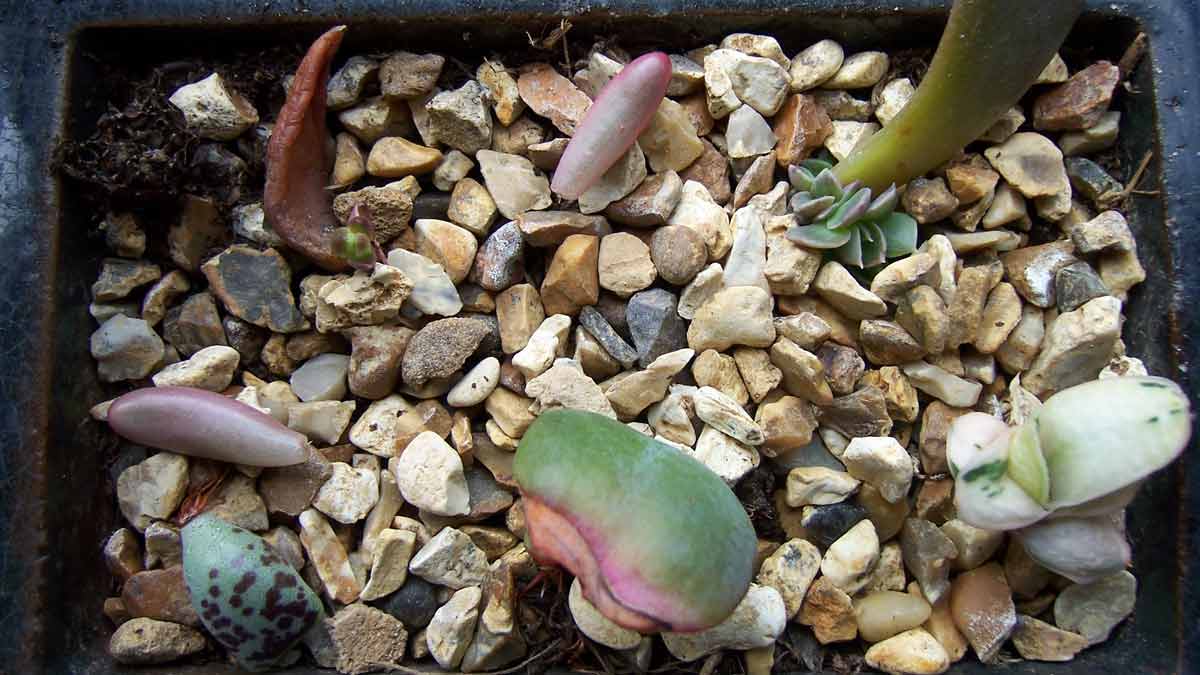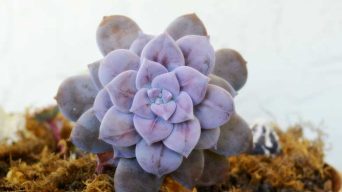Succulents are a beautiful addition to any home that needs a little bit of color.
They’re also very low maintenance and easy to care for, making them perfect for those who don’t have much time.
However, succulent leaves falling off is a common problem that many succulent owners face.
If you’re wondering why succulent leaves fall off and what to do about it, then read on!
What Causes Succulent Leaves To Fall Off
Succulents are very hardy plants. They can survive through harsh conditions and still keep their leaves intact.
However, succulents can still suffer from diseases and conditions that make them lose their leaves.
It is important to take succulent leaves falling off as a sign that something is wrong with the plant.
The most common causes of leaves falling off succulents are:
Overwatering
One of the most common causes of succulent leaves falling off is overwatering.
Water that sits on the soil for long periods can cause rot in succulents’ roots.
If caught early, you can rescue your succulent that has been overwatered by cutting away any damaged parts and repotting it to fresh soil.
Underwatering
Succulent leaves can fall off if they are underwater for long periods.
While succulents can survive being watered infrequently, it is important to ensure that the roots get enough water now and then.
This means watering succulents when their soil or leaves start to feel dry.
Extreme Temperatures
Temperature can also cause succulent leaves to fall off.
While succulents are hardy plants, they cannot survive freezing temperatures. They should be kept indoors if the temperature is expected to drop below 60 degrees Fahrenheit.
They can also be affected by high temperatures.
If succulents are kept in very hot places, they might droop and lose their leaves when the temperature becomes too much for them to handle.
Too Much Sunlight
Succulents need bright light to stay healthy.
However, succulent leaves falling off is a sign that the succulents are getting too much sunlight.
They can lose their leaves if they get direct exposure to the sun for long periods without any protection from shade or water.
Lack of Sunlight
While succulents need sunlight to grow, succulent leaves falling off is also a sign that they are not getting enough light.
Succulents should be kept in bright places all the time for them to stay healthy and strong. They should also be exposed to sunlight for around six hours every day.
Soil Problems
Succulents can lose their leaves if there’s something wrong with the soil they’re in.
Succulents need soils that are loose and well-drained.
They also like succulent mixes, which contain more sand than other kinds of potting soil to help promote drainage and airflow around their roots.
Root Rot
Root rot is a common problem among succulent plants since they have large surface areas where roots are exposed to the elements.
Succulent leaves characterize that wilt, turn brown or yellowish, and fall off at their base.
Fungal Infection

If succulent leaves are turning black and falling off, it might be a sign of succulent rot.
One common cause is when fungi attack succulents’ roots or stem after they’ve already been weakened by lack of water, excess sunlight, extreme temperatures, or other reasons that can damage succulents from the inside out.
This succulent rot can be treated by removing the succulent and its soil from the pot, washing off any dirt or debris attached to it, cutting away rotted parts of succulents’ stems or roots, and repotting them succulents in fresh succulent soil.
Pests
Succulents can be infested with pests like aphids, mealybugs, and scale insects.
These bugs suck succulent plants’ sap to survive.
If succulents are infested with these bugs for too long, they will lose their leaves as a defense mechanism against the pests that threaten them.
Chemical Damage
Pesticides can cause succulent leaves to fall off if exposed to them for too long or in high doses.
To prevent succulents from succumbing to pesticides, you must wash your hands before handling succulent plants and avoid using chemical substances like fertilizers and pesticides as much as possible.
Repotting Issues
Succulents might also leave succulent leaves behind if their roots are being disturbed during repotting.
If you notice succulents shedding succulent leaves, it’s important not to touch or disturb them while their root systems recover from the repotting process.
Just let them get acclimated in a new pot before removing succulent leaves that have fallen off on their own.
Using Wrong Pot
Succulents succulent leaves fall off if they are kept in pots that don’t fit them.
Succulents should always be repotted into pots that best accommodate their needs.
You can also use succulent planters to house multiple succulents at once and let them grow together as a collection.
Natural Fall
Succulents naturally shed their succulent leaves when they are ready to propagate.
When succulent plantlets form at the base of a leaf, it is because that particular succulent phase has ended, and another one will soon follow.
If you notice succulents dropping their succulent leaves, wait for them to fall off on their own before removing them from the succulent pot.
What To Do When Succulent Leaves Fall Off?

When succulents start to lose leaves, succulent owners often feel worried.
The good news is that succulents are low-maintenance plants and losing a few leaves here or there does not indicate any severe damage to the plant–as long as their normal leaf growth pattern resumes after some time.
Succulents will naturally shed old leaves over time; succulents will also shed leaves if exposed to certain conditions, such as too much direct sunlight or not enough water.
To help your succulents re-grow their leaves and prevent succulents from shedding their leaves in the future, follow these tips:
Keep Succulent Plants Out of Direct Sunlight
Succulents need bright indirect light to thrive indoors but can be exposed to full sunlight for hours at a time when you’re bringing them in and out of your home.
If they are kept in direct sunlight for too long, succulents may start to sunburn and lose their leaves.
Water Succulents Sparingly
Succulents thrive when they are watered just enough to keep their leaves from wilting, but that means you should avoid overwatering or underwatering succulents.
If succulents don’t get the water they need, their leaves will start to dry and fall off, even if it’s only occasionally.
Succulents need time to breathe and absorb water through their roots, so succulent owners should wait until the soil is completely dry before adding more water.
Wait to Repot Succulents Until New Leaves Appear on Succulent Plants
Succulents can recover from lost or damaged leaves as long as they have enough time for their roots to grow healthy again before the plant is repotted.
Succulent owners should wait at least a few weeks after succulents lose their leaves before repotting succulent plants.
Provide Succulents With a Cactus MIX or Succulent Soil
Succulents need to be planted in pots with drainage holes and succulent potting mixes, which are different from regular potting soils because they drain faster and hold less moisture.
Succulents don’t do well if their roots stay soggy for too long.
Prune Succulent Plants by Removing Dead Succulent Leaves
Succulents need to be pruned to keep them looking neat and tidy.
Succulents grow new leaves at the end of their branches, so it’s essential to remove dead leaves regularly by pinching them off with fingers or cutting them away with scissors or a sharp knife.
Protect Succulent Plants From Pests
Mealybugs and Aphids are common succulent pests that can damage succulents.
Succulents should be inspected regularly for signs of these pests, which look like cottony white spots on succulent leaves or stems. In severe cases, mealybugs cover succulent plants from stem to stern with their waxy white bodies.
To prevent succulents from succulent plant pests, you should always inspect succulents for signs of these bugs before bringing them inside the home and throughout the year–especially if they live in humid climates where pests thrive.
Keep Succulents Away From Drafty Areas
Succulents are houseplants that need protection from cold drafts.
If succulents get exposed to too many cold drafts, their leaves will start drying and falling off because succulents can’t recover if they’re exposed to very dry air for long periods.
You should keep succulents away from things like vents and heating units.
Place Succulents in the Right Temperature Range
Succulents thrive when grown indoors, which means succulent owners should place succulents where temperatures stay between 60 F and 75 F (15 C to 24 C).
Succulent plants can be placed outside during the summer months, but succulents should be brought back inside as temperatures drop.
Fertilize Succulent Plants Once a Month During the Growing Season
Succulents need their nutrients regularly replenished, which succulent owners can do by feeding succulents a balanced succulent plant fertilizer once a month during the growing season.
Succulents should never be fertilized in winter because succulent plants are dormant in cold temperatures.
What Are The Benefits Of Succulent Leaves Falling Off
Leaves falling off naturally is a process that succulents go through.
They are not losing their leaves because of a disease, but succulent leaf drop is essential for the health and growth of succulent plants.
Leaves falling off helps the succulent to conserve water, remove old leaves and absorb more sunlight. It can also help strengthen the stem of succulents to support their weight better.
Succulent leaves falling off can be a natural succulent cycle.
A succulent plant in good health will retain its leaves until they naturally reach the end of their life cycle and naturally fall off.
During this succulent cycle, the succulents receive more sunlight and water, which helps strengthen their stems so they can hold up their heavy succulent structure better than before.
This leads to bigger and healthier succulents!
If your succulents are losing leaves, it is a crucial cycle that you should let the succulents go through.
What To Do With Succulent Leaves That Fall Off?
Succulents are often propagated from leaves, so you can use succulent leaves that have fallen off to grow new plants.
New succulent plants can be grown from leaf cuttings.
How to Grow Succulent Plants from Leaves?
Leaf succulent propagation is a simple process. You can start succulents from leaves by following these steps:
- Take a succulent leaf and let it callous over for a few days
- Stick the succulent leaf in some succulent soil mix.
- Keep the succulent moist until it has grown new roots and is ready to be planted.
- After the succulent has grown new roots, you can plant it in a new pot or container.
You might need to wait for up to three weeks before your leaf succulents start growing again after rooting them from leaves.
Final Thoughts
Succulent plants are very easy to care for. However, succulents leaves may fall off due to overwatering or different conditions.
It is important to take preventative measures before succulent leaves droop and become damaged.
If your succulent leaves already have visible damage, it is best to cut the leaf off as soon as possible with a sharp object and treat the succulent by giving it proper watering and sunlight to prevent further damage.
Succulents are very resilient, and it is normal for succulent leaves to fall off, but if not taken care of properly, succulents can get damaged or die.







